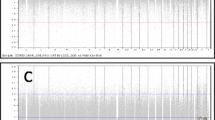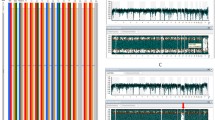Abstract
Purpose
To examine the prevalence of aneuploidy in human blastocysts resulting from donated eggs and embryo implantation after transfer of normal euploid embryos. Also, to assess the necessity of preimplantation genetic screening (PGS) for embryos produced with donor eggs.
Methods
Blastocysts from donor-recipient cycles were biopsied for PGS (PGS group) and the samples were analyzed with DNA microarray. Euploid blastocysts were transferred to the recipients, and both clinical pregnancy and embryo implantation were examined and compared with embryos without PGS (control group).
Results
After PGS, 39.1 % of blastocysts were abnormal, including aneuploidy and euploid with partial chromosome deletion and/or duplication. Transfer of normal euploid blastocysts brought about 72.4 % of clinical pregnancy, 65.5 % of ongoing/delivery and 54.9 % of embryo implantation rates; these rates were slightly higher than those in the control group (66.7, 54.0 and 47.8 %, respectively), but there was no statistical difference between the two groups. By contrast, the miscarriage rate was higher in the control group (19.2 %) than in the PGS group (9.5 %), but no statistical difference was observed. Transfer of two or more embryos did not significantly increase the ongoing/delivery rates in both groups, but significantly increased the twin pregnancy rates (50.0 % in the PGS group and 43.8 % in the control group).
Conclusion(s)
High proportions of human blastocysts derived from donor eggs are aneuploid. Although pregnancy and embryo implantation rates were increased, and miscarriage rates were reduced by transfer of embryos selected by PGS, the efficiency was not significantly different as compared to the control, suggesting that PGS may be necessary only in some specific situations, such as single embryo transfer.


Similar content being viewed by others
References
Hassold T, Hunt P. To err(meiotically) is human: the genesis of human aneuploidy. Nat Rev Genet. 2001;2:280–91.
Wang WH, Sun QY. Meiotic spindle, spindle checkpoint and embryonic aneuploidy. Front Biosci. 2006;11:620–36.
Jones KT. Meiosis in oocytes: predisposition to aneuploidy and its increased incidence with age. Hum Reprod Update. 2008;14:143–58.
Chiang T, Schultz RM, Lampson MA. Meiotic origins of maternal age-related aneuploidy. Biol Reprod. 2012;86:1–7.
Liu J, Wang W, Sun X, Liu L, Jin H, Li M, et al. DNA microarray reveals that high proportions of human blastocysts from women of advanced maternal age are aneuploidy and mosaic. Biol Reprod. 2012;87:1–9.
Baart EB, Martini E, van den Berg I, Macklon NS, Galjaard RJ, Fauser BC, et al. Preimplantation genetic screening reveals a high incidence of aneuploidy and mosaicism in embryos from young women undergoing IVF. Hum Reprod. 2006;21:223–33.
Yang Z, Liu J, Collins J, Salem SA, Liu X, Lyle SS, et al. Selection of single blastocysts for fresh transfer via standard morphology assessment alone and with array CGH for good prognosis IVF patients: results from a randomized pilot study. Mol Cytogenet. 2012;5:24–9.
Schultz RM. From egg to embryo: a peripatetic journey. Reproduction. 2005;130:825–8.
Scott RT, Ferry K, Su J, Tao X, Scott K. Comprehensive chromosome screening in highly predictive of the reproductive potential of human embryos: a prospective, blinded, nonselection study. Fertil Steril. 2012;97:870–5.
Liang LF, Wang CT, Sun X, Liu L, Jin H, Li M, et al. Identification of chromosomal errors in human preimplantation embryos with oligonucleotide DNA microarray. PLoS One. 2013;8, e61838.
Munne S, Sandalinas M, Escudero T, Marquez C, Cohen J. Chromosome mosaicism in cleavage stage human embryos: evidence of a maternal age effect. Reprod Biomed Online. 2002;4:223–32.
Munne S, Sandalinas M, Magli C, Gianaroli L, Cohen J, Warburton D. Increased rate of aneuploid embryos in young women with previous aneuploid conceptions. Prenat Diagn. 2004;24:638–43.
Battaglia DE, Goodwin P, Klein NA, Soules MR. Influence of maternal age on meiotic spindle assembly in oocytes from naturally cycling women. Hum Reprod. 1996;11:2217–22.
Macklon NS, Fauser BC. Transfer of only a single embryo in in-vitro fertilization. Ned Tijdschr Geneeskd. 2003;147:1301–4.
Svobodová M, Brezinová J, Oborná I, Dostál J, Lubuský M. Prevention of multiple pregnancy after IVF/ICSI by elective single embryo transfer–pilot study. Ceska Gynekol. 2005;70:343–7.
Karaki RZ, Samarraie SS, Younis NA, Lahloub TM, Ibrahim MH. Blastocyst culture and transfer: a step toward improved in vitro fertilization outcome. Fertil Steril. 2002;77:114–8.
Franasiak JM, Forman EJ, Hong KH, Werner MD, Upham KM, Treff NR, et al. The nature of aneuploidy with increasing age of the female partner: a review of 15,169 consecutive trophectoderm biopsies evaluated with comprehensive chromosomal screening. Fertil Steril. 2014;101:656–63.
Sills E, Li X, Frederick JL, Khoury CD, Potter DA. Determining parental origin of embryo aneuploidy: analysis of genetic error observed in 305 embryos derived from anonymous donor oocyte IVF cycles. Mol Cytogenet. 2014;7:68.
Racowsky C, Vernon M, Mayer J, Ball GD, Behr B, Pomeroy KO, et al. Standardization of grading embryo morphology. J Assist Reprod Genet. 2010;27:437–9.
Spandorfer SD, Chung PH, Kligman I, Liu HC, Davis OK, Rosenwaks Z. An analysis of the effect of age on implantation rates. J Assist Reprod Genet. 2000;17:303–6.
Platteau P, Staessen C, Michiels A, Van Steirteghem A, Liebaers I, Devroey P. Preimplantation genetic diagnosis for aneuploidy screening in women older than 37 years. Fertil Steril. 2005;84:319–24.
Wang WH, Meng L, Hackett RJ, Odenbourg R, Keefe DL. Limited recovery of meiotic spindles in living human eggs after cooling-rewarming observed with polarization light microscope. Hum Reprod. 2001;16:2374–8.
Wang WH, Meng L, Hackett RJ, Odenbourg R, Keefe DL. Rigorous thermal control during ICSI stabilizes the meiotic spindle and improves fertilization and pregnancy rates. Fertil Steril. 2002;77:1274–7.
Pickering SJ, Braude PR, Johnson MH, Cant A, Currie J. Transient cooling to room temperature can cause irreversible disruption of the meiotic spindle in the human oocytes. Fertil Steril. 1990;54:102–8.
Baart EB, Martini E, Eijkemans MJ, Van Opstal D, Beckers NG, Verhoeff A, et al. Milder ovarian stimulation for in-vitro fertilization reduces aneuploidy in the human preimplantation embryo: a randomized controlled trial. Hum Reprod. 2007;22:980–8.
Gardner DK, Vella P, Lane M, Wagley L, Schlenker T, Schoolcraft WB. Culture and transfer of human blastocysts increases implantation rates and reduces the need for multiple embryo transfers. Fertil Steril. 1998;69:84–8.
Pandian Z, Marjoribanks J, Ozturk O, Serour G, Bhattacharya S. Number of embryos for transfer following in vitro fertilisation or intra-cytoplasmic sperm injection. Cochrane Database Syst Rev. 2013;29:7.
Van Echten-Arends J, Mastenbroek S, Sikkema-Raddatz B, Korevaar JC, Heineman MJ, van der Veen F, et al. Chromosomal mosaicism in human preimplantation embryos: a systematic review. Hum Reprod Update. 2011;17:620–7.
Author information
Authors and Affiliations
Corresponding author
Additional information
Capsule Aneuploidy rate is high in human blastocysts resulting from donated eggs and, transfer of normal euploid embryos may facilitate the implementation of single embryo transfer without reducing live birth rate per embryo transfer.
Rights and permissions
About this article
Cite this article
Haddad, G., Deng, M., Wang, C.T. et al. Assessment of aneuploidy formation in human blastocysts resulting from donated eggs and the necessity of the embryos for aneuploidy screening. J Assist Reprod Genet 32, 999–1006 (2015). https://doi.org/10.1007/s10815-015-0492-4
Received:
Accepted:
Published:
Issue Date:
DOI: https://doi.org/10.1007/s10815-015-0492-4




